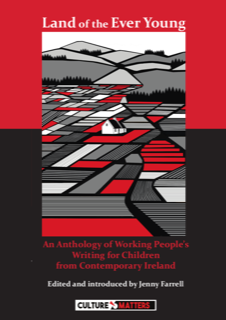■ Jenny Farrell (editor), Land of the Ever Young: An Anthology of Writing for Children by Working People from Contemporary Ireland (Culture Matters, 2021; €12)
If the cultural mainstream is an expression of the ruling ideas in a society, and therefore the ideas of the ruling class, then children’s literature is not exempt from this.

Mainstream children’s literature extols the middle-class family, its superiority and its values as unchangeable. The many children living in poverty do not find their life experience reflected in such books.
Land of the Ever Young is the final volume of a set of three anthologies of working people’s writing from contemporary Ireland published by Culture Matters. It contains thirty stories and poems for children, to help them understand the world around them and give them the confidence that injustice can be tackled, and that the world can be changed.
As in the two preceding volumes, this anthology includes texts in Irish as well as English, emphasising the Irish-language tradition in working people’s writing. This includes Tomás Mac Síomóin’s poem “An Teachín Liath / The Grey House,” an appeal to the radical power of imagination. To find your utopia you must think outside the box, not be confined by “stale formulas or with words | Prayers also will not serve, | the laws obscure the way | only the stairs of your heart’s desire | can bring you to his secret.”
James O’Brien’s autofiction “A Little Table for Packy” describes a childhood experience that children who have witnessed the current pandemic can easily relate to: “An epidemic of diphtheria had broken out across the city and claimed scores of lives.” Packy’s father cannot visit him, despite his life-threatening illness, because he has to work in England.
Also set in a hospital is Alan Weadick’s “Four Eyes.” The boy at the centre of this contemporary story also is away from home, the safety of his world shaken, with a dawning realisation of another, not entirely benign reality outside his own mind.
Several writers retell older texts, both Irish and European. Ross Walsh reimagines three fairy tales popularised by the Grimm Brothers, writing grim tales of today. “Puss in Boots and the Ogre” begins: “Once upon a time, there was a big tall apartment block in a huge city. Most of the people who lived in these apartments did not have much money.” A female cat helps these people set things right. In “The Blue Lighter” a magician helps a worker to help the workers in a factory. In Walsh’s version of “Little Red Riding Hood” both Wolf and Grandma act decisively when faced with a present-day dilemma.
Eileen Keane tells of a small sheep farmer’s relationship with his young daughter, teaching her about the work, folklore and traditional songs of north Connemara. The people who work the land are its true inheritors. Anne Mac Darby-Beck’s story “The Fairy Fort” tells of a child’s courage in defeating superstition, showing that a human child can conquer a fairy king.
Gabriel Rosenstock shows in “The Blind Ones” how superstition and prejudice blind people and removes them from their true heritage.
Blindness is also at the heart of Michael Casey’s “Fabled Isle,” where only a boy can see what is happening: “He wondered how it was that no one else on the island had known what was going on under their very noses.”
Frank Murphy’s story “A New Deal” shows the decadence and hollowness of the ruling class in the tradition of Dickens and Tressell.
Alan O’Brien in “The Old Man and the Blackbird,” and Moya Roddy in “Seagull,” explore the kindness of an old man and a young girl towards injured birds.
People’s bond with nature is a theme in many of the stories, including Anne Mac Darby-Beck’s retelling of Oscar Wilde’s story “The Nightingale and the Rose.” Kindness to animals and to nature is a measure of humanity.
Several writers explore aspects of Irish history. Gráinne Daly reimagines the famous meeting of 1593 between the Connacht chieftain Gráinne Ní Mháille and the English queen Elizabeth.
Liz Gillis takes a look at more recent history in her story about three young girls involved in the Irish Revolution, “working-class girls who wanted to and did, make a difference.” Celia de Fréine’s “Wearing the Trousers” propels readers into 1950s Ireland and the prejudices against women at that time.
Several writers set their stories in schools, or on the block, such as Karl Parkinson’s “Blockhood,” Declan Geraghty’s “Saturn 2000s,” and Camillus John’s “The Sponsored Cat-Squeeze.” Moya Roddy imagines Galway children’s action in helping to save the environment in “Your House is on Fire Your Children will Burn.” The covid pandemic and its impact on the lives of inner-city Dublin children is the theme of Cathy Scuffil’s essay “Children Making History.” “When we look back at historic events, we very rarely hear or read of the experiences of children, especially children from working-class areas.”
The heroines and heroes confront wrongs, challenge superstition and injustice. Together they possess the qualities necessary to make society a better place, a home for a happy future, a Tír na nÓg. Karen Dietrich’s illustrations expand the humanist themes in the stories and help make them truly memorable, for children and adults alike.
The project is a pioneering venture that has been fully supported by the trade union movement in recognition of the importance of creativity and the right of the working class to express the wealth of their culture and to articulate their experience of life.
■ Land of the Ever Young is available from Culture Matters (www.culturematters.org.uk), Connolly Books, Dublin (www.connollybooks.org), An Ceathrú Póilí, Belfast (www.anceathrupoili.com), and Charlie Byrne’s (charliebyrne.ie) and Kenny’s Bookshops (www.kennys.ie), Galway.





